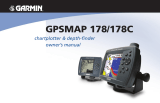
GMM™ Installation Instructions
Important Safety Information
WARNING
See the Important Safety and Product Information guide in the
product box for product warnings and other important
information.
When connecting the power cable, do not remove the in-line
fuse holder. To prevent the possibility of injury or product
damage caused by fire or overheating, the appropriate fuse
must be in place as indicated in the product specifications. In
addition, connecting the power cable without the appropriate
fuse in place will void the product warranty.
CAUTION
Always wear safety goggles, ear protection, and a dust mask
when drilling, cutting, or sanding.
NOTICE
When drilling or cutting, always check what is on the opposite
side of the surface.
Registering Your Device
Help us better support you by completing our online registration
today.
• Go to http://my.garmin.com.
• Keep the original sales receipt, or a photocopy, in a safe
place.
Contacting Garmin Product Support
• Go to www.garmin.com/support and click Contact Support
for in-country support information.
• In the USA, call (913) 397.8200 or (800) 800.1020.
• In the UK, call 0808 2380000.
• In Europe, call +44 (0) 870.8501241.
Tools Needed
• Drill and drill bits
• #2 Phillips screwdriver
• Marine sealant
• Jigsaw
• File and sandpaper
Mounting Considerations
NOTICE
This device should be mounted in a location that is not exposed
to extreme temperatures or conditions. The temperature range
for this device is listed in the product specifications. Extended
exposure to temperatures exceeding the specified temperature
range, in storage or operating conditions, may cause device
failure. Extreme-temperature-induced damage and related
consequences are not covered by the warranty.
Using the included hardware and template, you can mount the
device using one of two methods. You can use the included
bracket and hardware to bail mount the device, or you can use
the included template and hardware to flush mount the device in
the dashboard. To mount the device so it appears flat with the
front of the dashboard, you must purchase a flat-mount kit (sold
separately, with professional installation recommended) from
your Garmin
®
dealer.
When selecting a mounting location, observe these
considerations.
• The location should not be directly exposed to the elements.
The rear housing of the device is not water or weather-
resistant.
• The location should provide optimal viewing as you operate
your boat.
• The location should allow for easy access to all device
interfaces, such as the keypad, touchscreen, and card
reader, if applicable.
• The location must be strong enough to support the weight of
the device and protect it from excessive vibration or shock.
• To avoid interference with a magnetic compass, the device
should not be installed closer to a compass than the
compass-safe distance value listed in the product
specifications.
• The location must allow room for the routing and connection
of all cables.
Mounting the Device
NOTICE
Be careful when cutting the hole to flush mount the device.
There is only a small amount of clearance between the case
and the mounting holes, and cutting the hole too large could
compromise the stability of the device after it is mounted.
A blue rubber seal is included for each DVI port on the device.
This seal must be installed between each DVI port and DVI-
cable connector to avoid damage to the connectors.
A gray rubber seal is included for each VGA port on the device.
This seal must be installed between each VGA port and VGA-
cable connector to avoid damage to the connectors. When
installing the seal, the arrow on the side of the seal must point
toward the device.
The included template and hardware can be used to flush
mount the device in your dashboard. To mount the device so
the screen is flat with the dashboard, you must purchase a flat-
mount kit from your Garmin dealer.
1
Trim the template and make sure it fits in the location where
you want to flush mount the device.
2
Remove the protective liner from the back of the template
and adhere it to the location where you want to mount the
device.
3
Using a
3
/
8
in. (9.5 mm) drill bit, drill one or more of the holes
inside the corners of the solid line on the template to prepare
the mounting surface for cutting.
4
Using a jigsaw, cut the mounting surface along the inside of
the solid line indicated on the template.
5
Place the device in the cutout to test the fit.
6
If necessary, use a file and sandpaper to refine the size of
the cutout.
7
After the device fits correctly in the cutout, ensure the
mounting holes on the device line up with the larger
9
/
32
in.
(7.2 mm) holes on the template.
8
If the mounting holes on the device do not line up, mark the
new hole locations.
9
Using a
9
/
32
in. (7.2 mm) drill bit, drill the larger holes.
10
Starting in one corner of the template, place a nut plate
À
over the larger hole
Á
drilled in step 9.
May 2013
190-01559-02_0C Printed in Taiwan





